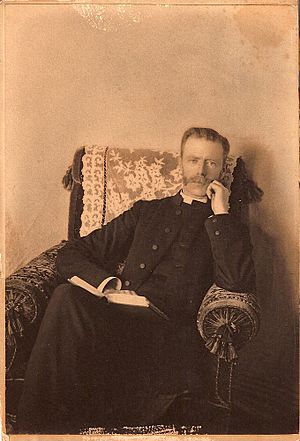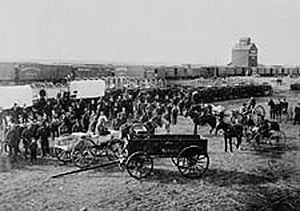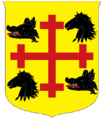George Exton Lloyd facts for kids
Quick facts for kids George Lloyd |
|
|---|---|
| Anglican Bishop of Saskatchewan | |
 |
|
| Church | Anglican Church of Canada |
| See | Saskatchewan |
| In Office | 1922–1931 |
| Predecessor | Jervois Arthur Newnham |
| Successor | William Thomas Thompson Hallam |
| Orders | |
| Ordination | 1885 |
| Personal details | |
| Born | 6 January 1861 London, England |
| Died | 8 December 1940 (aged 79) Victoria, British Columbia |
| Spouse | Marion Tuppen |
George Exton Lloyd (born January 6, 1861 – died December 8, 1940) was an Anglican bishop and a leader in the church. He helped create Lloydminster, a city located on the border of Alberta and Saskatchewan in Canada. He served as the Bishop of Saskatchewan from 1922 to 1931.
Contents
Early Life and Education
George Lloyd was born in London, England. He received his early education at home and later attended St. John's College, London. In 1881, he moved to Canada to study theology, which is the study of religious faith. He studied at Wycliffe College and the University of Toronto.
Joining the North-West Rebellion
Before he finished his studies, George Lloyd joined the Queen's Own Rifles of Canada. He fought in the North-West Rebellion, also known as the Riel Rebellion. During the Battle of Cut Knife, near Battleford, Saskatchewan, he showed great bravery. He provided cover fire for another soldier, Edward Acheson. Lloyd was seriously injured during this battle.
Family and School Leadership
In 1885, Lloyd became an ordained minister in Winnipeg. In the same year, he married Marion Tuppen. They moved to Rothesay, New Brunswick, where he took charge of a private school. He renamed it Rothesay College for Boys. Later, a local leader named James F. Robertson helped the school become Rothesay Collegiate School. Today, it is known as Rothesay Netherwood School.
The Barr Colony and Lloydminster
In 1900, Lloyd returned to England. He wrote a letter to The Times newspaper in 1902. In his letter, he suggested that Western Canada was a great place for people to move to. He received thousands of responses from people interested in emigrating.
He then became involved in a large emigration project with Isaac Montgomery Barr. Lloyd and his family traveled with many other settlers, known as the Barr colonists. More than 2,600 colonists joined the journey. However, the travel plans were not well organized. For example, they crossed the ocean on a ship meant for fewer passengers.
When they arrived in Saint John, New Brunswick, Barr disappeared. Lloyd had to step in and arrange train travel for the colonists to Saskatoon. Barr eventually reappeared. About 1,500 colonists continued their journey by wagon and on foot. The trip was about 275 kilometers (170 miles) long.
By the time they reached Battleford, the colonists were very unhappy with Barr's leadership. They asked Lloyd to become their new leader. The settlers eventually named their new home "Lloydminster" to honor him. Lloyd and his family stayed in Lloydminster for a few years. Then, they moved to Prince Albert. There, he became the principal of Emmanuel College from 1908 to 1916. He also helped students build Rugby Chapel.
Becoming Bishop of Saskatchewan
In 1922, George Lloyd was chosen to be the Bishop of Saskatchewan. He served in this important role until 1931. After that, he retired and moved to British Columbia. He passed away in 1940.
His Views and Legacy
George Lloyd had strong beliefs about Canada's future. He believed that Canada should be settled mainly by immigrants from Britain. He also worked to ensure that children of non-British immigrants learned English and British history.
He also made an important change within the Anglican church in Saskatchewan. He stated that there should be no difference between men and women when choosing delegates or committee members. This meant that both sexes could be equally involved in church decisions.
Bishop Walter Burd, who followed Lloyd in his role, described him as a memorable figure. He recalled Lloyd saying, "Young man, there is no hope for men who have holes in the seats of their trousers, but there is hope for men who have holes in the knees of their trousers." This quote suggests Lloyd valued hard work and effort.
See also
Images for kids




